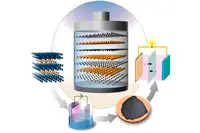 A high performance cathode material developed by researchers from Drexel University in the US, in association with Aix-Marseille University, is said to have great promise for use in next generation lithium-sulphur batteries.
A high performance cathode material developed by researchers from Drexel University in the US, in association with Aix-Marseille University, is said to have great promise for use in next generation lithium-sulphur batteries.
A high performance cathode material developed by researchers from Drexel University in the US, in association with Aix-Marseille University, is said to have great promise for use in next generation lithium-sulphur batteries.
While lithium-sulphur batteries have higher energy density than lithium-ion, one of the challenges for the technology is to find cathode materials that demonstrate long term stability.
Looking to address the issue, Dr Yury Gogotsi from Drexel has created a two dimensional carbon/sulphur nanolaminate that could be a candidate cathode. The team did so by extracting the nanolaminate from a material called a Ti2SC MAX phase – one of a family of layered ceramics.
According to the team, carbon/sulphur nanolaminates have covalent bonding between carbon and sulphur and an extremely uniform distribution of sulphur between atomically thin carbon layers.
The nanolaminates synthesised by Dr Gogotsi's group are said to demonstrate the same uniformity as infiltrated carbon nanomaterials, but the sulphur in the nanolaminates is deposited uniformly in the carbon matrix as atomically thin layers. This, says the team, may have a significant impact on increasing the life span of next generation batteries.
"We have enough evidence to show that electrochemical etching can be a powerful method to selectively extract the M elements from the MAX phases, to produce a variety of AX layered structures that cannot be made otherwise," said Meng-Qiang Zhao, Dr Gogotsi's post doctoral associate.
"It is not difficult to foresee that the AX structures represent a new family of nanostructured materials, much of which will probably be 2D," Dr Gogotsi said. "The various A and X combinations already known make AX structures attractive for a number of potential applications, such as electrical energy storage and catalysis."
Author
Graham Pitcher
Source: www.newelectronics.co.uk

